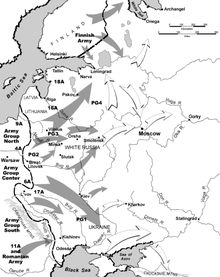
Back Operasie Barbarossa Afrikaans Operación Barbarroya AN عملية بربروسا Arabic Operación Barbarossa AST Barbarossa əməliyyatı Azerbaijani بارباروسا عملیاتی AZB План Барбароса Byelorussian Плян Барбароса BE-X-OLD Операция „Барбароса“ Bulgarian অপারেশন বারবারোসা Bengali/Bangla
| Operation Barabarossa | |||||||
|---|---|---|---|---|---|---|---|
| Part of the Eastern Front of World War II | |||||||
 | |||||||
| |||||||
| Belligerents | |||||||
|
|
| ||||||
| Commanders and leaders | |||||||
|
|
| ||||||
| Strength | |||||||
|
~3 million 3,600 tanks, 4,389 aircraft[1] 46,000 artillery pieces |
~5.7 million 12,000-15,000 tanks, 35,000-40,000 aircraft (11,357 combat ready on 22 June 1941)[2] | ||||||
| Casualties and losses | |||||||
|
186,452 killed 40,157 missing 655,179 hurt 2,827 aircraft destroyed 2,735 tanks destroyed |
802,191 killed 1,336,147 hurt 2,835,000 captured.[3][4] 21,200 aircraft destroyed[5][6][7] 20,500 tanks lost | ||||||
Operation Barbarossa (German: Unternehmen Barbarossa, named after Frederick I) was the code name for the European Axis invasion of the Soviet Union during World War II. It began on 22 June 1941. More than 3 million men attacked along the 2,900 km front, which made it the largest military invasion in human history.[8] It also involved 600,000 motor vehicles and 750,000 horses.[9]
In the Molotov-Ribbentrop pact of 1939 Germany and the Soviet Union agreed not to fight each other. Planning for the German surprise attack started in December 1940. The attack was to start on May 15, and its main objective was to destroy the Soviet military power. Some Nazi ideological goals were included, as were Soviet deposits of natural resources, which would be helpful to keep fighting the war against the Allies.
Even though the Soviet Red Army suffered huge losses, the attack did not complete its objectives. The Germans held some of the most important economic areas of the Soviet Union, mainly in Ukraine.[10] However, the Germans were pushed back from Moscow.
The German attack opened the Eastern Front, which in Russia is called the "Great Patriotic War". In the following years Axis powers could not do another attack as large and long as Operation Barbarossa.[11]
- ↑ Bergström, p130
- ↑ Bergström 2007, p. 131-2: Uses Soviet Record Archives including the Rosvoyentsentr, Moscow; Russian Aviation Research Trust; Russian Central Military Archive TsAMO, Podolsk; Monino Air Force Museum, Moscow.
- ↑ "About the German Invasion of the Soviet Union". Archived from the original on 2009-02-01. Retrieved 2011-04-15.
- ↑ THE TREATMENT OF SOVIET POWS: STARVATION, DISEASE, AND SHOOTINGS, JUNE 1941- JANUARY 1942
- ↑ Bergström, p117
- ↑ Krivosheyev, G. 1993
- ↑ Note: Soviet aircraft losses include all causes
- ↑ World War II Chronicle, 2007. Legacy/ Publications International, Ltd. Page 146.
- ↑ "Yad vashem - Chronology of the Holocaust". Archived from the original on 2005-03-11. Retrieved 2011-04-15.
- ↑ A.J.P Taylor & Colonel D. M Proektor, p. 106
- ↑ A.J.P. Taylor & Colonel D. M Proektor 1974, p. 107